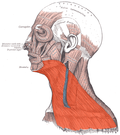| Platysma muscle | |
|---|---|
 The platysma is visible, with skin removed. | |
 The muscles of the face, platysma visible at bottom right. | |
| Details | |
| Origin | Subcutaneous tissue of infraclavicular and supraclavicular regions |
| Insertion | Base of mandible; skin of cheek and lower lip; angle of mouth; orbicularis oris |
| Artery | Branches of the submental artery and suprascapular artery |
| Nerve | Cervical branch of the facial nerve |
| Actions | Draws the corners of the mouth inferiorly and widens it (as in expressions of sadness and fright). Also draws the skin of the neck superiorly when teeth are clenched |
| Antagonist | Masseter muscle, temporalis muscle |
| Identifiers | |
| Latin | platysma |
| TA98 | A04.2.01.001 |
| TA2 | 2147 |
| FMA | 45738 |
| Anatomical terms of muscle | |
The platysma muscle or platysma is a superficial muscle of the human neck that overlaps the sternocleidomastoid. It covers the anterior surface of the neck superficially. When it contracts, it produces a slight wrinkling of the neck, and a "bowstring" effect on either side of the neck.

